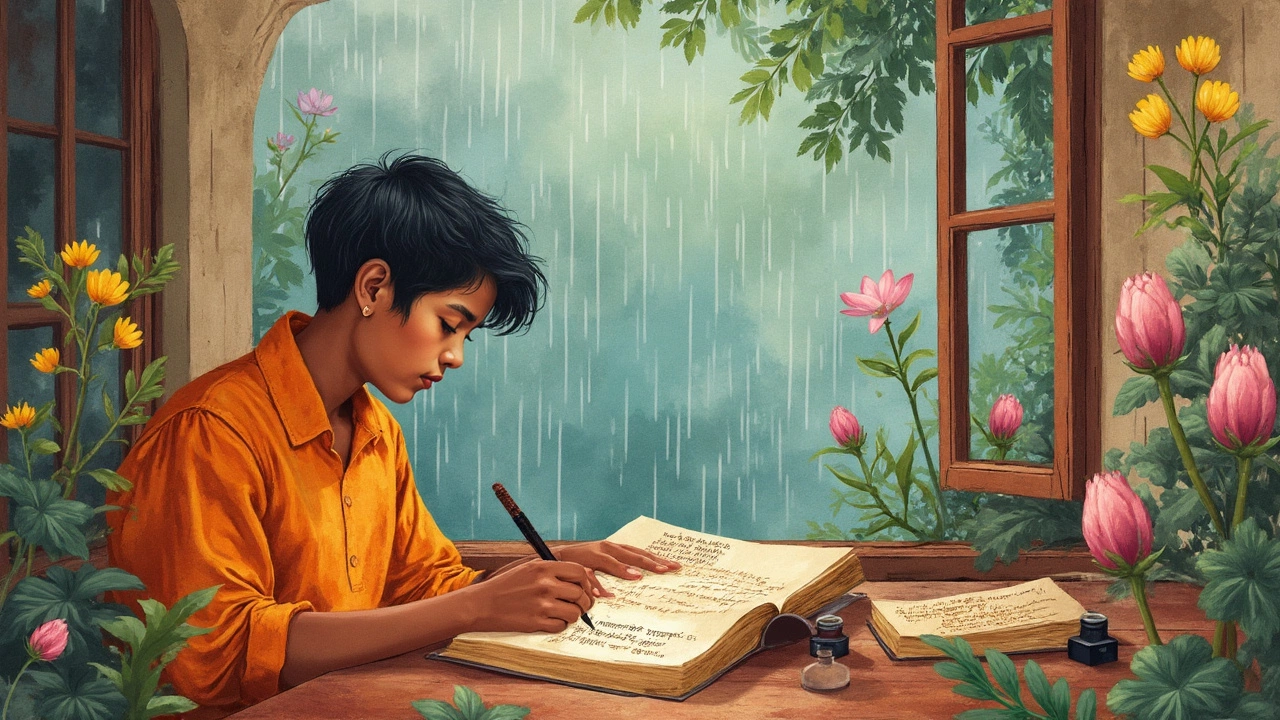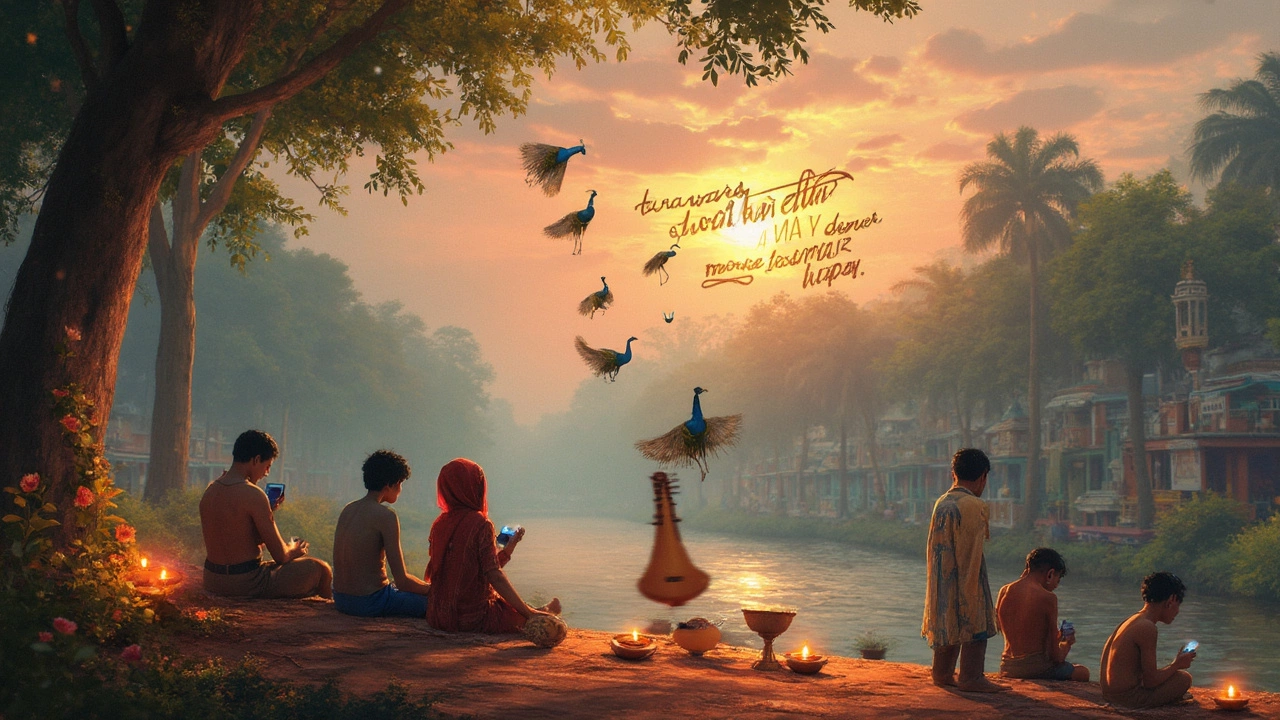Very Short Poem: How to Write Micro Poetry that Packs a Punch
 May, 18 2025
May, 18 2025
If you think poetry is all about long verses and complicated words, you’re missing out on the easiest trick. A very short poem is just what it sounds like: a poem with only a handful of words—sometimes just two or three lines, or even a single sentence. No extra fluff. These little poems can be just as punchy and meaningful as the longest epic.
Ever scrolled past quotes or one-liners that made you stop and think? That’s the power of a super short poem. In India, you’ll find these everywhere, from WhatsApp statuses to Instagram captions, and even on rickshaws. Micro poetry travels fast because it fits perfectly into busy lives and short attention spans. There’s no need to memorize a long verse to feel something real.
- What Makes a Poem 'Very Short'
- Why Short Poems Matter
- Traditional Indian Short Forms
- Tips to Write Your Own Micro Poem
What Makes a Poem 'Very Short'
A very short poem isn’t just a poem that’s missing some lines. It’s about squeezing a big thought or feeling into just a few words. Usually, it’s under 10 lines—most are just 1 to 4 lines. The real magic is that it makes an impact fast, without wasting time or space. You’ll see these called micro poetry, short verse, or sometimes even single-sentence poems.
Some famous forms have set rules. Take the Japanese haiku, just 3 lines and 17 syllables. Or the Indian doha, popularized by Kabir and Rahim, which follows a 24+13 syllable split over 2 lines. But there are also even shorter forms, like a 2-line shayari or the trending Twitter poem (the character limit is 280, so you can’t go wild with words).
Here’s a quick breakdown of what usually makes a poem ‘very short’:
- Length: 1 to 6 lines (most often)
- No strict rules for rhyme or meter, unless you’re sticking to a very specific form
- Direct language—no unneeded words or old-school wording
- One main idea or feeling
Short poems show up everywhere. On Indian social media, some poets have reached thousands—sometimes millions—of readers through micro poetry. For example, in 2023, #micropoetry got over 450,000 posts on Instagram in India alone. People love sharing and reading these because they fit into a single breath—easy to remember, easy to pass on.
Check out this simple table for a snapshot of different short poetry forms:
| Form | Lines | Origin |
|---|---|---|
| Haiku | 3 | Japan |
| Doha | 2 | India |
| Shayari | Often 2-4 | India/Pakistan |
| Twitter Poem | 1-6 (140-280 chars) | Global |
So, if someone asks, "What counts as a very short poem?"—just remember, it’s not the exact line count but how tightly you package the punch. Less is more, but the feeling still has to land.
Why Short Poems Matter
People don’t have hours to sit with a book these days. Tiny poems work perfectly because they’re quick to read and easy to remember. They fit into pretty much any part of life—printed on a T-shirt, in a WhatsApp message, or even as a sticky note on your mirror.
The magic is in how short poems leave a mark. They say a lot without dragging on. Just think about haiku—the Japanese three-line poem—or even Indian couplets (doha), like the ones by Kabir. Their messages get stuck in your head because they are short and sharp. A 2022 survey by Poetry Foundation found that younger readers prefer poems under 10 lines, and most people remember tiny verses from childhood or social media way better than longer pieces.
Short poems are also awesome for self-expression. You don’t need to be a trained writer or spend all day editing. With only a few words, you can share your feelings, spark a laugh, or break bad news gently. Schools love using them to help kids build vocabulary and confidence because pretty much anyone can try their hand at writing micro poems.
- Quick to read, easy to share
- Perfect for busy routines and mobile screens
- Help boost creativity—word choice matters more
- Great for beginners or anyone nervous about writing
| Type of Poem | Typical Length | Common Use |
|---|---|---|
| Haiku | 3 lines | Nature themes, social media |
| Doha | 2 lines | Philosophy, folk wisdom |
| Micro poem | 1-4 lines | Emotions, quick messages |
The real win? A very short poem can travel further and last longer than you think. This is why you find them popping up everywhere, from textbooks to WhatsApp forwards in India and all over the world.

Traditional Indian Short Forms
India’s got a huge tradition of very short poem styles that people still use today. If you’ve heard of “doha” or “shayari,” you already know a bit about it. These aren’t new Instagram trends—they’ve been around for hundreds of years and still hit hard because they’re simple and direct.
The doha is an all-time classic. Kabir, Rahim, and Tulsidas made this form famous by smashing big life lessons into just two lines. That’s it—two lines, often with 24 syllables (13+11), and you get a mini life lesson. Some of these are so well known, people still drop them in daily conversations or on social media.
Here’s an example of a Kabir doha:
“Dheere dheere re mana, dheere sab kuch hoye
Maali seenche sau ghara, ritu aaye phal hoye”
— Kabir
Translation: “Slow down, everything takes its own time. A gardener may water a plant a hundred times, but the fruit appears only in its season.” See how it’s short but straight to the point?
Another famous style is haiku, but with a twist. While haiku is Japanese, Indian poets use the three-line trick too—often mixing folk languages or Hindi with simple, real feelings. And let’s not forget shayari. Though shayari can be long, the ones that go viral are usually just two lines. Those punchline poems you read on WhatsApp? Pure desi micro poetry!
- Doha: 2 lines, usually about morals or life lessons.
- Shayari (short form): 2 lines, packs an emotional punch, usually in Hindi or Urdu.
- Muktak: 1 or 2 lines, self-contained idea.
Here’s some data about their popularity:
| Type | Average Lines | Year It Became Popular | Current Use |
|---|---|---|---|
| Doha | 2 | 1500s | Quotes, education, social media |
| Shayari | 2 | 1700s | Texts, memes, events |
| Muktak | 1-2 | 1800s | Social posts, competitions |
Short poetry in India isn’t just text; it’s a habit. School kids use them in essays, elders share them in gatherings, and you see them on posters everywhere. As scholar Harivansh Rai Bachchan once said,
"A poem’s strength often lies in how little it uses to say so much."
Learning these forms isn’t about being traditional—it actually gives your own poems an edge, making your words stick in people’s minds.
Tips to Write Your Own Micro Poem
Writing a very short poem sounds simple, but it’s all about getting straight to the point without losing the feeling. Some of the best micro poems come from a single moment or thought. You don’t need a fancy background in literature—just a bit of attention and honesty.
- Start with a spark: Grab a strong emotion, memory, or image. Micro poems work best when you pick something you really feel or see clearly.
- Cut the extra words: Every word counts. For example, famous Japanese haiku has just 17 syllables. In India, the doha keeps tight lines—usually just two. Try to write your message in less than 20 words.
- Play with structure: You can use one line, two lines, or three. There are no hard rules. Some Indian forms, like the muktak, allow just a single thought.
- Check the punch: Read your poem out loud. If it feels sharp and memorable, you’re on the right track. If it drags, cut more.
Short poems in India are often inspired by life around us—love, struggles, hope. Even Bollywood lyricists use quick, punchy lines that stick in your head. In 2024, a survey from Instagram India found that short, text-based posts (under 30 words) got 45% more likes and shares than longer ones. That’s proof: people love things that are quick and clear.
| Form | Usual Length | Fun Fact |
|---|---|---|
| Haiku | 3 lines, 17 syllables | Originated in Japan, adopted by Indian poets for nature poems |
| Doha | 2 lines, usually rhymed | Kabir is the most famous doha writer in India |
| Muktak | 1 to 2 lines | Popular in Hindi and Urdu poetry gatherings |
One last tip: if it doesn’t make you feel something in 10 seconds, try again. Good micro poetry is like a quick shot of chai—small but strong!